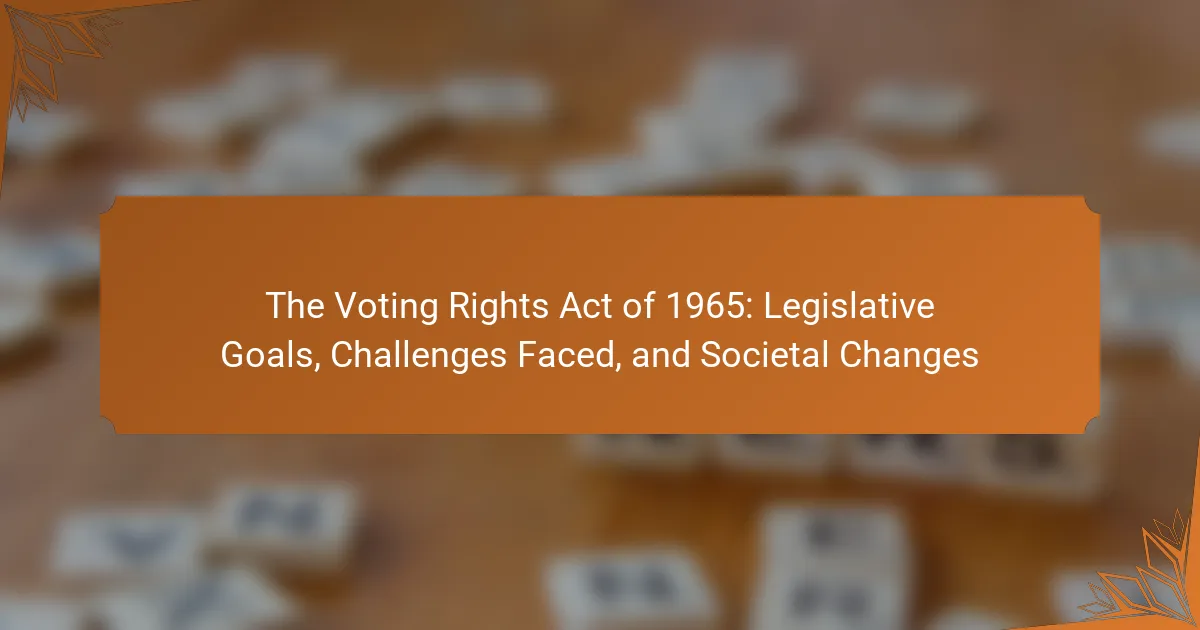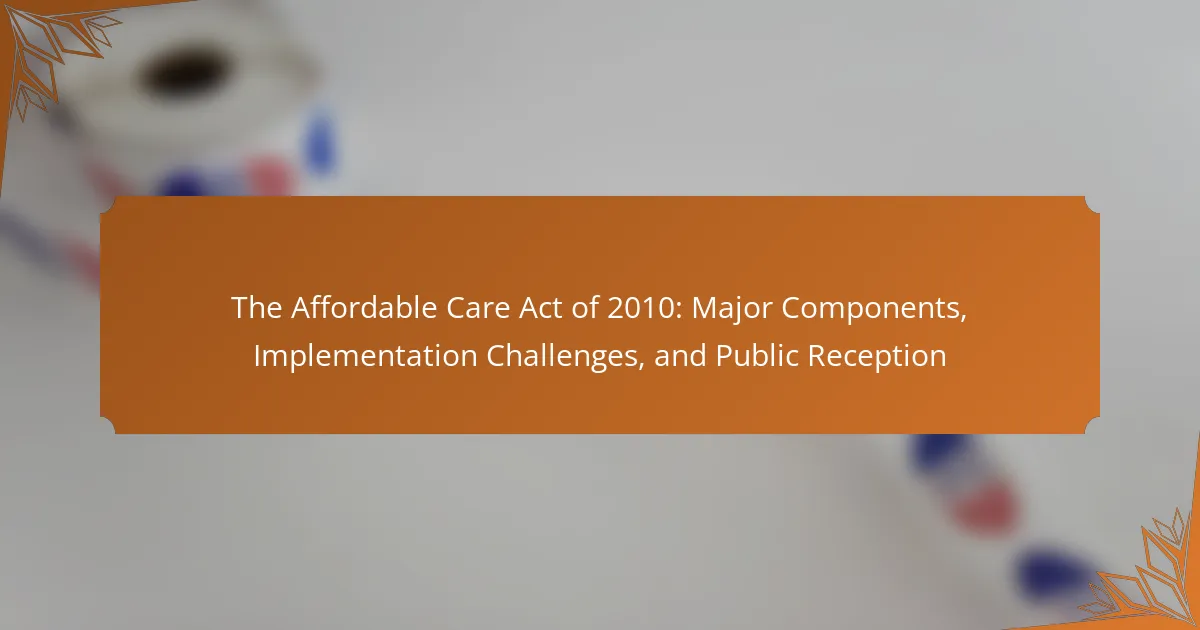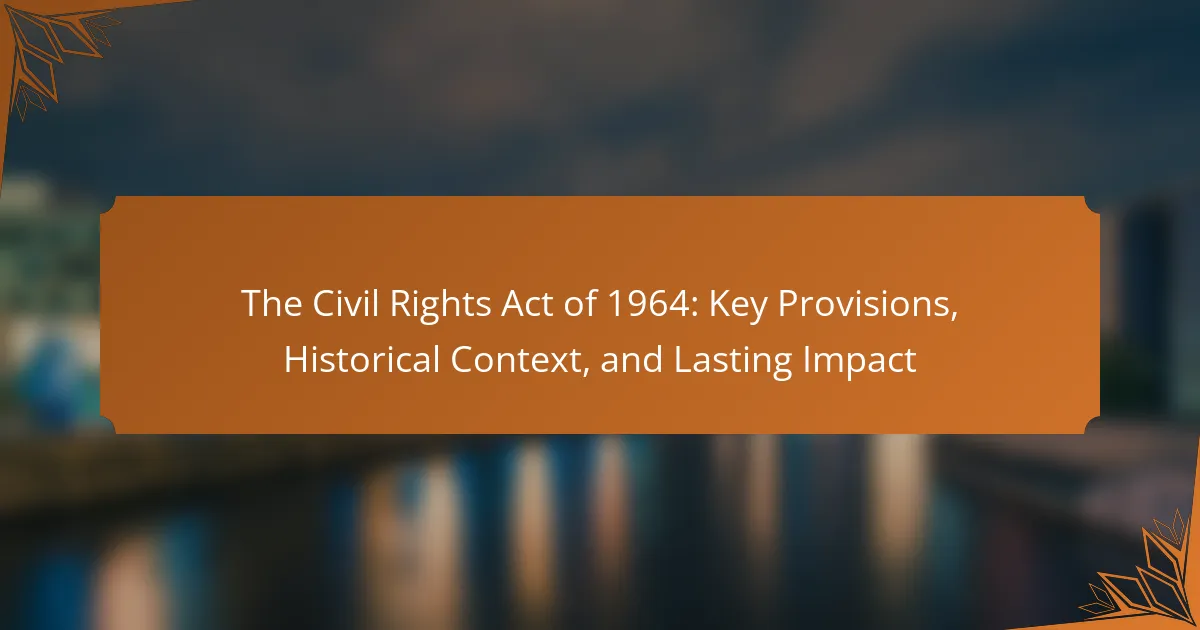The Voting Rights Act of 1965 is a pivotal federal law in the United States designed to eliminate racial discrimination in voting, particularly affecting African American voters in the Southern states. Signed into law by President Lyndon B. Johnson, the Act abolished discriminatory practices such as literacy tests and mandated federal oversight for jurisdictions with a history of voting discrimination. It significantly boosted voter registration and participation among African Americans and laid the groundwork for future legislation aimed at enhancing voter access, including the National Voter Registration Act of 1993 and the Help America Vote Act of 2002. Despite its ongoing significance, the Act faces challenges, particularly following the Supreme Court’s 2013 ruling that weakened key provisions, leading to concerns over voter suppression in various states. The article will explore the legislative goals of the Voting Rights Act, the challenges it has encountered, and the societal changes it has influenced over the years.
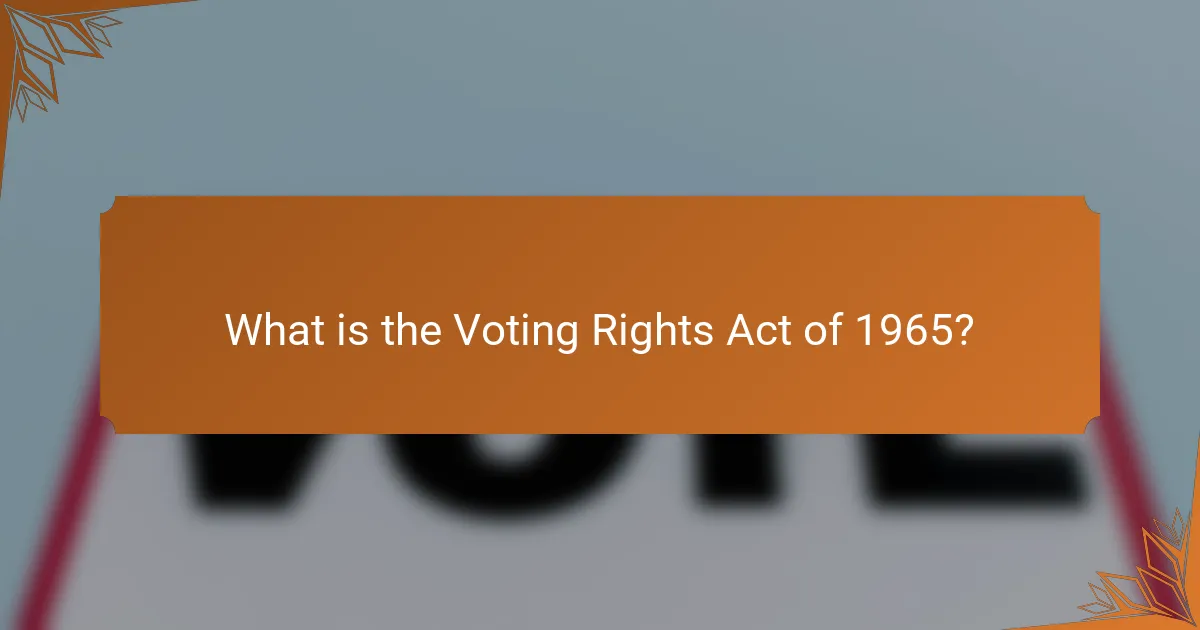
What is the Voting Rights Act of 1965?
The Voting Rights Act of 1965 is a landmark piece of federal legislation in the United States. It aimed to eliminate various forms of racial discrimination in voting. The Act was signed into law by President Lyndon B. Johnson on August 6, 1965. It specifically targeted practices that disenfranchised African American voters, particularly in the Southern states. Key provisions included the prohibition of literacy tests and the requirement for jurisdictions with a history of discrimination to obtain federal approval before changing voting laws. The Act significantly increased voter registration and participation among African Americans. It is widely regarded as a crucial step in the civil rights movement. The legislation has been amended several times to extend protections and address ongoing discrimination.
What were the key legislative goals of the Voting Rights Act?
The key legislative goals of the Voting Rights Act were to eliminate racial discrimination in voting. This Act aimed to enforce the voting rights guaranteed by the 14th and 15th Amendments. It sought to remove barriers like literacy tests and poll taxes. The Act also aimed to provide federal oversight of voter registration in areas with a history of discrimination. Additionally, it established mechanisms for federal intervention in states that violated voting rights. The Act was a response to widespread voter suppression, particularly in Southern states. Its passage was a significant step toward achieving racial equality in the electoral process.
How did the Voting Rights Act aim to eliminate racial discrimination in voting?
The Voting Rights Act aimed to eliminate racial discrimination in voting through several key provisions. It prohibited discriminatory practices like literacy tests that were used to disenfranchise Black voters. The Act also authorized federal oversight of voter registration in areas with a history of discrimination. Additionally, it provided for federal examiners to ensure fair voting practices. The legislation aimed to protect the voting rights of all citizens, particularly African Americans in the South. Historical context shows that before the Act, many states employed tactics to suppress Black voter turnout. The Act significantly increased voter registration among African Americans, demonstrating its effectiveness in combating racial discrimination in voting.
What specific provisions were included in the Voting Rights Act?
The Voting Rights Act of 1965 included several specific provisions aimed at eliminating racial discrimination in voting. It prohibited literacy tests and other discriminatory practices used to disenfranchise voters. The Act required jurisdictions with a history of discrimination to obtain federal approval before changing voting laws. Additionally, it aimed to protect the voting rights of all citizens, particularly African Americans. The Act also provided for federal oversight of voter registration and elections in certain areas. These provisions were designed to ensure equal access to the voting process. The Act significantly increased voter registration and participation among minority groups.
What challenges did the Voting Rights Act face during its implementation?
The Voting Rights Act faced significant challenges during its implementation. Resistance from state and local officials was prevalent, particularly in Southern states. Many jurisdictions employed discriminatory practices to suppress voter registration among African Americans. Literacy tests and poll taxes were common obstacles. Furthermore, the Act’s enforcement mechanisms were often underfunded and under-resourced. The federal government faced pushback from those who opposed federal oversight of state elections. Court challenges also arose, questioning the constitutionality of certain provisions. These factors collectively hindered the full realization of the Act’s goals.
How did state resistance impact the enforcement of the Voting Rights Act?
State resistance significantly hindered the enforcement of the Voting Rights Act. Many Southern states employed discriminatory practices to suppress Black voter registration. Tactics included literacy tests, poll taxes, and intimidation at the polls. These measures directly countered the Act’s intent to ensure equal voting rights. Federal intervention was often required to combat such resistance. The Act authorized federal oversight of voter registration in areas with a history of discrimination. Despite this, state officials frequently found ways to circumvent federal authority. Legal battles and local resistance delayed the Act’s full implementation for years.
What legal challenges arose against the Voting Rights Act?
Legal challenges against the Voting Rights Act included cases questioning its constitutionality. Key challenges arose from states claiming it infringed on their rights. In 2013, the Supreme Court case Shelby County v. Holder invalidated the formula used to determine jurisdictions needing federal oversight. This decision significantly weakened the Act’s enforcement mechanisms. Other cases involved disputes over voter ID laws and redistricting practices. These challenges often cited states’ rights and the need for local control. The legal landscape continues to evolve as new challenges emerge.
What societal changes resulted from the Voting Rights Act of 1965?
The Voting Rights Act of 1965 led to significant societal changes in the United States. It eliminated legal barriers preventing African Americans from voting. This legislation resulted in increased voter registration among Black citizens. For example, in Mississippi, Black voter registration rose from 6.7% in 1964 to over 59% by 1967.
The act also fostered greater political representation for African Americans. By 1970, the number of Black elected officials increased from 300 to over 1,400. The Voting Rights Act catalyzed broader civil rights advancements. It inspired activism and awareness regarding racial equality in various sectors.
Additionally, it laid the groundwork for subsequent legislation aimed at protecting civil rights. The act’s enforcement mechanisms led to federal oversight of elections in areas with a history of discrimination. Overall, the Voting Rights Act of 1965 significantly transformed the political landscape in America.
How did voter registration and participation change after the Voting Rights Act?
Voter registration and participation significantly increased after the Voting Rights Act of 1965. The Act aimed to eliminate barriers to voting for African Americans. Prior to its passage, discriminatory practices limited voter registration. After the Act, federal oversight of voter registration in certain states began. This led to a dramatic rise in registered voters. For example, from 1964 to 1965, the number of registered Black voters in Mississippi increased from 6.7% to 59.8%. Nationally, the percentage of eligible Black voters who were registered rose from 29% in 1964 to 53% in 1968. This increase in voter registration contributed to higher participation rates in elections. The Voting Rights Act empowered federal authorities to enforce voting rights. Overall, the Act was instrumental in transforming the electoral landscape for African Americans.
What role did the Voting Rights Act play in the civil rights movement?
The Voting Rights Act of 1965 was crucial in advancing the civil rights movement. It aimed to eliminate barriers preventing African Americans from voting. Prior to the Act, discriminatory practices like literacy tests and poll taxes were widespread. The Act outlawed these practices, ensuring federal oversight of voter registration in areas with a history of discrimination. This legislation led to a significant increase in African American voter registration and participation. By 1966, over 1 million African Americans had registered to vote in the South. The Act also empowered federal authorities to monitor elections, protecting the rights of voters. Overall, the Voting Rights Act was a landmark achievement that helped secure voting rights for marginalized communities.
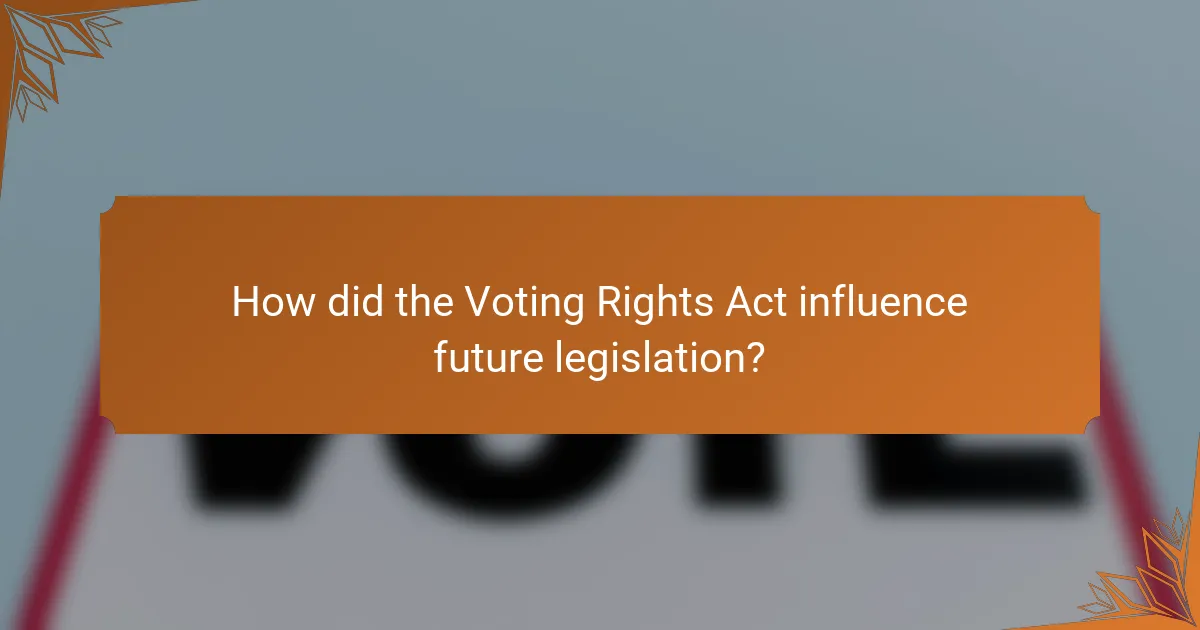
How did the Voting Rights Act influence future legislation?
The Voting Rights Act of 1965 significantly influenced future legislation by establishing a precedent for federal intervention in state voting laws. It aimed to eliminate racial discrimination in voting, leading to increased voter registration among African Americans. This act prompted subsequent legislation, such as the National Voter Registration Act of 1993, which further facilitated voter access. It also inspired the Help America Vote Act of 2002, aimed at improving voting systems and accessibility. Additionally, the Voting Rights Act set a legal framework for challenging discriminatory practices, reinforcing civil rights protections. Its legacy continues to shape debates on voting rights and access in America.
What subsequent laws were inspired by the Voting Rights Act?
The Voting Rights Act inspired several subsequent laws aimed at protecting voting rights. The National Voter Registration Act of 1993 aimed to increase voter registration. The Help America Vote Act of 2002 addressed issues in voting systems and procedures. The Voting Rights Amendment Act of 2014 sought to restore protections weakened by Supreme Court decisions. Each of these laws reflects the ongoing commitment to ensure fair voting access.
How did the Voting Rights Act set a precedent for voting rights protections?
The Voting Rights Act of 1965 established a legal framework for protecting voting rights in the United States. It prohibited racial discrimination in voting practices. This legislation aimed to eliminate barriers such as literacy tests and poll taxes that disenfranchised minority voters. The Act empowered the federal government to oversee voter registration and elections in areas with a history of discrimination. It also introduced measures like federal monitoring of elections in specific jurisdictions. These provisions set a benchmark for future voting rights legislation. The Act’s success led to further protections, including the National Voter Registration Act of 1993. The Voting Rights Act remains a cornerstone of civil rights law, influencing ongoing debates about voting access and equity.
What impact did the Voting Rights Act have on minority representation in government?
The Voting Rights Act significantly increased minority representation in government. It abolished discriminatory practices that hindered voting for African Americans and other minorities. Following its passage in 1965, the number of registered Black voters in the South surged. For instance, in Mississippi, Black voter registration rose from 6.7% in 1964 to 59.8% by 1967. This surge led to the election of more minority officials at local, state, and federal levels. By 1970, the number of Black elected officials in the U.S. increased from 300 to over 1,500. The Act’s enforcement provisions also empowered federal oversight of elections in states with a history of discrimination. This contributed to a more equitable political landscape, enhancing democratic participation among minorities.
What criticisms have been directed at the Voting Rights Act over the years?
Criticisms of the Voting Rights Act have included claims of federal overreach. Opponents argue that it infringes on states’ rights to regulate elections. Some critics contend that the Act’s provisions are outdated. They believe that the conditions justifying its special measures no longer exist. Additionally, there are concerns about the effectiveness of certain provisions. Critics highlight that some states have found ways to circumvent the Act. The Supreme Court’s 2013 decision in Shelby County v. Holder weakened key protections. This ruling invalidated the formula used to determine which jurisdictions required federal approval for changes to voting laws. Critics argue this has led to voter suppression efforts in several states.
How have interpretations of the Voting Rights Act evolved?
Interpretations of the Voting Rights Act have evolved significantly since its enactment in 1965. Initially, the Act aimed to eliminate racial discrimination in voting. Over time, courts have interpreted its provisions differently, especially regarding Section 5, which required federal approval for changes to voting laws in certain states. In 2013, the Supreme Court’s decision in Shelby County v. Holder invalidated the coverage formula used to determine which jurisdictions were subject to preclearance. This ruling led to a resurgence of state-level voting restrictions, raising concerns about voter suppression. Additionally, interpretations have shifted to address issues such as voter ID laws and gerrymandering. Ongoing debates continue to shape the understanding and application of the Act in contemporary society.
What are the arguments for and against the reauthorization of the Voting Rights Act?
Arguments for the reauthorization of the Voting Rights Act include the need to protect minority voting rights. Historical data shows that voter suppression tactics disproportionately affect marginalized communities. Proponents argue that the Act addresses these inequalities effectively. They cite instances of discriminatory practices in various states as justification for continued federal oversight.
Arguments against the reauthorization focus on claims of federal overreach. Critics argue that states should manage their own voting regulations. They assert that the Act’s provisions are outdated and no longer necessary. Some believe that the existing laws provide sufficient protections for all voters. These opposing views highlight a divide in perspectives on voting rights and state sovereignty.
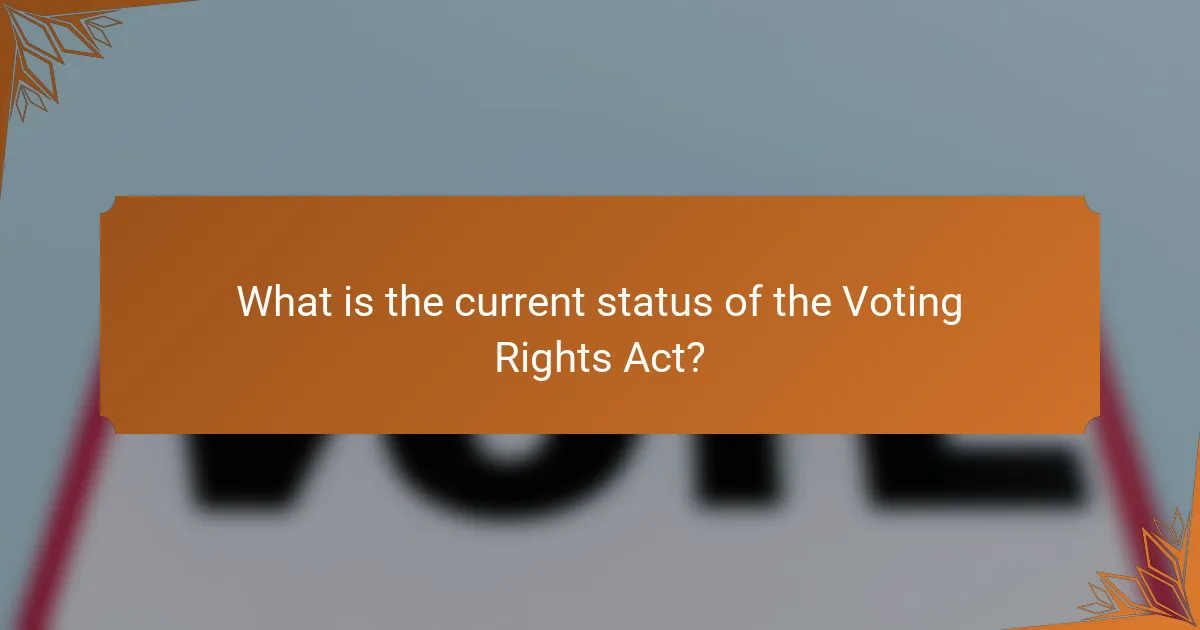
What is the current status of the Voting Rights Act?
The current status of the Voting Rights Act is that it remains in effect but faces significant challenges. Key provisions of the Act were weakened by the Supreme Court’s 2013 decision in Shelby County v. Holder. This ruling invalidated the formula used to determine which jurisdictions required federal approval for changes to voting laws. As a result, several states enacted laws that critics argue suppress voter turnout. Efforts to restore and strengthen the Act have been introduced in Congress, but they have not yet passed. The ongoing debate highlights the importance of voting rights in the United States today.
How has the Supreme Court impacted the Voting Rights Act in recent years?
The Supreme Court has significantly impacted the Voting Rights Act in recent years. In 2013, the Court invalidated a key provision of the Act in Shelby County v. Holder. This decision removed the formula used to determine which jurisdictions required federal approval for changes to voting laws. As a result, many states enacted laws that critics argue suppress voter turnout. The Court’s rulings have led to increased concerns about racial discrimination in voting. In subsequent cases, the Court has upheld various state laws that critics claim disproportionately affect minority voters. These actions have sparked ongoing debates about the protection of voting rights in the United States.
What recent rulings have affected the provisions of the Voting Rights Act?
Recent rulings by the Supreme Court have significantly impacted the Voting Rights Act. In 2013, the Court invalidated a key provision of the Act in Shelby County v. Holder. This ruling removed the formula used to determine which jurisdictions required federal approval for changes to voting laws. In 2021, the Court further upheld state voting laws in Brnovich v. Democratic National Committee. This decision limited the scope of Section 2 challenges to voting practices. These rulings have weakened federal oversight and protections against discriminatory voting practices.
How are states currently addressing voting rights in light of the Voting Rights Act?
States are currently addressing voting rights through various legislative measures. Some states are enacting laws to expand access to voting. This includes measures like automatic voter registration and extended early voting periods. Other states are implementing stricter voter ID laws. These laws often aim to enhance election security but can lead to disenfranchisement. Additionally, some states are facing legal challenges over these voting laws. Courts are reviewing whether these laws comply with the Voting Rights Act. The ongoing debate reflects the tension between access and security in the electoral process. Overall, states are navigating a complex landscape of voting rights influenced by the Voting Rights Act.
What steps can individuals take to advocate for voting rights today?
Individuals can advocate for voting rights today by engaging in grassroots activism. They can join or support organizations focused on voting rights, such as the NAACP or ACLU. Volunteering for voter registration drives increases awareness and participation. Educating others about voting rights and the importance of civic engagement is crucial. Attending town hall meetings allows individuals to voice concerns and influence local policies. Contacting elected officials to express support for voting rights legislation is vital. Sharing information on social media raises awareness and mobilizes others. Participating in peaceful protests can draw attention to voting rights issues.
How can citizens participate in protecting and promoting voting rights?
Citizens can participate in protecting and promoting voting rights by engaging in advocacy and education. They can join organizations that focus on voting rights, such as the NAACP or ACLU. Volunteering for voter registration drives helps increase participation. Citizens can also attend town hall meetings to voice concerns about voting issues. Contacting elected officials to express support for voting rights legislation is crucial. Additionally, participating in peaceful protests raises awareness about voting rights challenges. Educating peers about their voting rights empowers communities. These actions contribute to a stronger democratic process and help uphold the principles established by the Voting Rights Act of 1965.
What resources are available for learning more about voting rights advocacy?
Resources for learning about voting rights advocacy include organizations, books, and online platforms. Key organizations are the American Civil Liberties Union (ACLU) and the NAACP. They provide extensive materials on voting rights issues. Books such as “The Voting Rights Act of 1965: The Legacy of the Voting Rights Act” by Charles S. Bullock III offer historical context. Online platforms like the Brennan Center for Justice provide research and advocacy tools. Additionally, educational websites like Vote.org offer practical guidance on voter registration and rights. These resources help individuals understand and engage in voting rights advocacy effectively.
The Voting Rights Act of 1965 is a landmark federal legislation aimed at eliminating racial discrimination in voting, particularly targeting practices that disenfranchised African American voters in the Southern states. Key provisions include the prohibition of literacy tests and federal oversight of voting law changes in jurisdictions with a history of discrimination. The Act significantly increased voter registration and participation among African Americans and played a crucial role in the civil rights movement. Challenges during its implementation included state resistance and legal disputes, leading to ongoing debates about voting rights protections. The Act has influenced subsequent legislation and remains a pivotal reference point in discussions about electoral access and equity in the United States.
